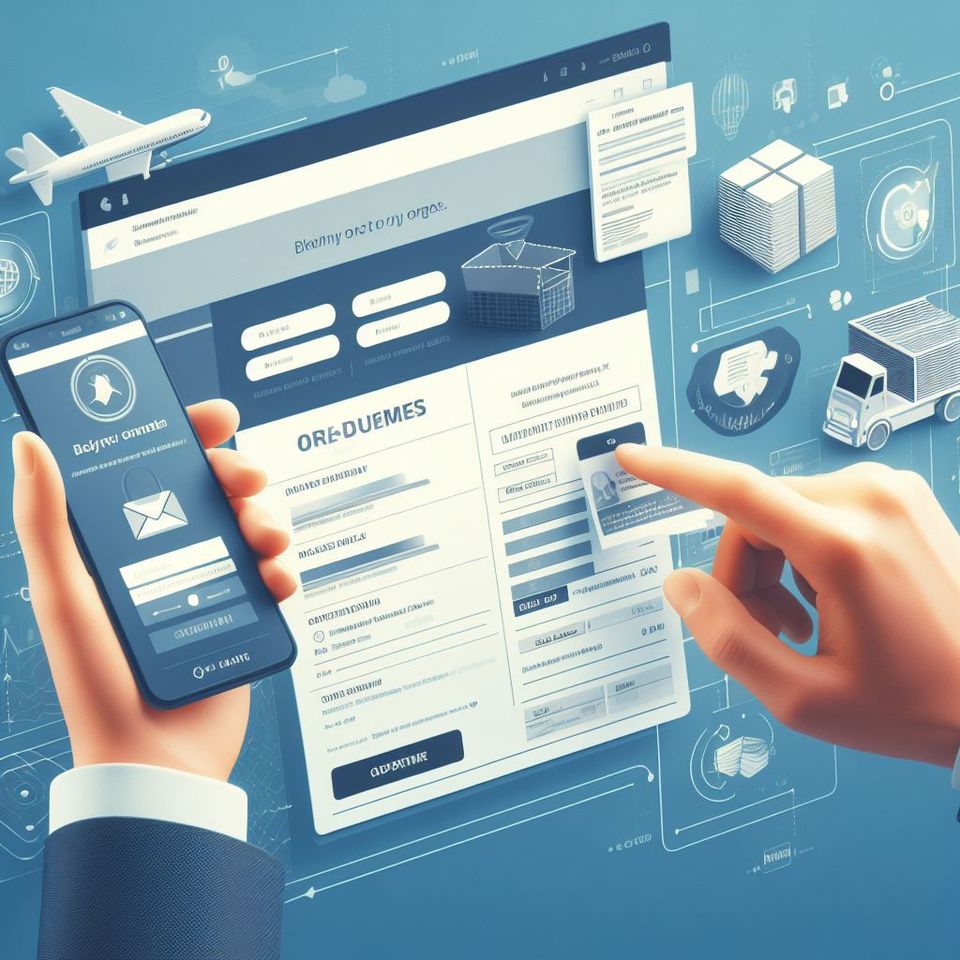Beyond the Checkout: Crafting an End-to-End B2B UX Journey

Welcome to the digital-first era, where every click, scroll and tap matters. If you're involved in B2B eCommerce, you know that providing a seamless user experience (UX) goes beyond the checkout. It's about shaping the entire B2B journey, from product discovery to payment completion.
In this article, we'll delve into the transformative power of expert UX in B2B payments, breaking down 11 B2B payment workflows in a 'before and after' style to demonstrate the real value of prioritizing user-centric design.
Analyze the Complete B2B User Journey
Picture this: you're in a bustling marketplace, searching for a product. In the physical world, this would involve navigating through aisles, comparing prices, and inspecting the merchandise. In the digital realm, the process should be just as intuitive and efficient.
Before: A disjointed experience where users navigate through convoluted menus, facing unclear product information and a clunky interface.
After: Streamlined product discovery with a user-friendly interface. Clear categories, concise product descriptions, and intuitive navigation ensure users find what they need effortlessly.
Cohesive UX and Customer Satisfaction
Think about the last time you had a frustrating online experience – perhaps a tedious checkout process or confusing payment options. In the B2B world, these pain points can lead to dissatisfaction, affecting customer retention and loyalty.
Before: Cumbersome payment workflows, confusing terminology, and a lack of transparency in transaction processes.
After: A seamless, user-friendly payment experience that minimizes friction. Clear instructions, intuitive design, and transparent communication contribute to increased customer satisfaction and loyalty.
Correlating UX Excellence with Long-Term Business Relationships
Now, let's talk numbers. Numerous industry reports affirm the link between UX excellence and long-term business relationships. According to a study by Forrester, companies investing in UX design see a return on investment of up to 1000%. Why? Because when users have a positive experience, they're more likely to return.
Before: Inconsistent UX leading to frustrated users, increased bounce rates, and a decline in customer trust.
After: A well-crafted UX strategy that ensures not only a smooth transaction but an overall positive experience. This leads to increased customer retention, improved brand perception, and ultimately, a healthier bottom line.
11 B2B Payment Workflows: Before and After
1. Account Onboarding
Before: Complex forms and unclear instructions leading to high dropout rates.
After: Simplified onboarding processes with intuitive form design, reducing friction and increasing user engagement.
2. Invoice Management
Before: Cumbersome navigation through spreadsheets and emails, leading to errors.
After: Streamlined invoice management systems, reducing manual errors and saving time for both businesses.
3. Payment Authorization
Before: Confusing authorization processes causing delays and frustration.
After: Clear, user-friendly authorization workflows, ensuring swift and secure transactions.
4. Expense Reporting
Before: Tedious and time-consuming expense reporting.
After: Simplified expense reporting systems, reducing administrative burdens and enhancing user productivity.
5. Transaction Tracking
Before: Limited visibility into transaction status, causing uncertainty.
After: Real-time transaction tracking, providing users with up-to-date information and building trust.
6. Dispute Resolution
Before: Complex dispute resolution processes leading to prolonged conflicts.
After: Streamlined dispute resolution processes, resolving issues efficiently and maintaining positive business relationships.
7. Multi-Currency Transactions
Before: Complicated processes for handling multi-currency transactions.
After: Intuitive interfaces for seamless multi-currency transactions, catering to a global user base.
8. Data Security Measures
Before: Insufficient security measures, raising concerns about data integrity.
After: Robust security protocols and transparent communication, instill confidence in users regarding the safety of their data.
9. Customized Reporting
Before: Limited options for generating and customizing reports.
After: Advanced reporting features, empowering businesses to extract valuable insights tailored to their needs.
10. Mobile Accessibility
Before: Limited functionality on mobile devices, hindering flexibility.
After: Mobile-optimized interfaces, allowing users to manage payments on the go with ease.
11. User Support and Education
Before: Limited support and educational resources, confusing.
After: Robust support systems and educational materials, empowering users to navigate the platform effectively.
The Case of Better Supplier Portals
Supplier portals let you complete payment-related tasks more efficiently. With all your payment information in one place and real-time tracking of payment status, you can save time and free up resources for business growth.
Consider the intricacies of supplier portals in B2B transactions. The journey involves not just the buyer but also the supplier, with interactions ranging from order fulfillment to payment processing.
Supplier Portal - Before
> A maze of unclear order tracking, complex payment terms, and inconsistent communication, causing delays and frustration for both parties.
Supplier Portal - After
> Streamlined supplier portals with real-time order tracking, transparent payment terms, and proactive communication.
This not only enhances the supplier's experience but also contributes to smoother transactions and strengthened business relationships.
In B2B transactions, where the supplier and buyer relationships are symbiotic, a well-designed UX in supplier portals becomes a cornerstone for successful collaboration.
The Power of UX Writing: Transforming Clunky Interfaces into Intuitive Experiences
Now, let's explore the often underestimated but incredibly powerful aspect of B2B payment optimization—UX writing. Imagine navigating a website or an app and running into unclear labels, confusing instructions, or jargon-filled prompts. It's like trying to decipher a map without key landmarks.
UX writing, when done right, transforms these clunky interfaces into places of vital contextual help, providing users with clear guidance and support throughout their journey. Here are some examples:
1. Contextual Help and Clarity:
Before
> "Error: Invalid input. Please correct and try again."
After
> "Oops! It looks like there's an issue with those details. Please double-check check details and try again.
Clear, concise, and friendly. The revised message not only informs the user of the error but guides them on how to rectify it, reducing frustration and promoting a positive experience.
2. Minimizing User Anxiety:
Before
> "Transaction Pending."
After
> "Your payment is in progress! Payments usually take 1-3 days to settle. You'll get an email when the payment settles."
By providing reassuring messages and maintaining transparency, UX writing helps alleviate user anxiety during critical moments of the payment process.
3. Error Prevention and Recovery
Before
> "Error 404: Page Not Found."
After
> "Uh-oh! It seems like the page you're looking for is taking a coffee break. Double-check the URL and try again after 1 minute."
User-centric UX writing not only communicates errors but offers actionable solutions, guiding users through unexpected situations. A little bit of humor can also defuse frustrating situations.
4. Microcopy for Smoother Interactions:
Before
> "Submit."
After
> "Confirm and Send."
Microcopy
They are tiny (but mighty!) bits of text scattered throughout an interface that clarify interactions and makes them more intuitive.
5. Inclusive Language:
Before
> "Invalid Username or Password."
After
> "It looks like something's not quite right. Double-check your username or password and try again."
Inclusive language acknowledges the user's effort, creating a more empathetic and user-friendly environment.
Conclusion
In business payments, where precision and clarity are paramount, the role of UX writing is indispensable. It goes beyond mere words on a screen; it guides, supports, and enhances the overall user experience.
As financial institutions and fintech companies seek to reap the fruits of UX transformation, integrating expert UX writing principles is non-negotiable. It's about creating an environment where every word contributes to the user's understanding, ensuring that each interaction is not just functional but delightful.
Remember this: the right words can turn a transaction into a conversation, a navigation into a guided tour. It's time to harness the power of UX writing and elevate your payment user experience to new heights.
Contact WDIR, the leading UX agency in business payments, and let us show you how the art of words can transform your interfaces, making them not just functional but places of assistance, guidance, and delight. Because in the experience-led era, every word matters, and every interaction shapes the journey.
